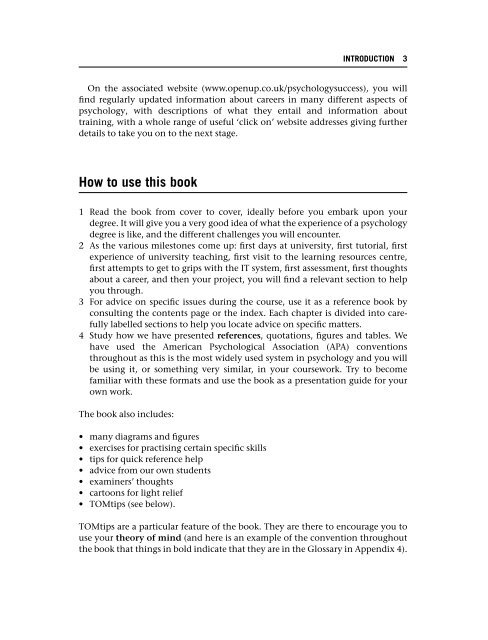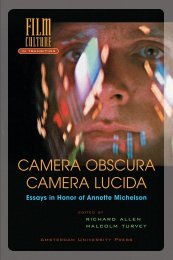Psychology - Forgot your username
Psychology - Forgot your username
Psychology - Forgot your username
Create successful ePaper yourself
Turn your PDF publications into a flip-book with our unique Google optimized e-Paper software.
On the associated website (www.openup.co.uk/psychologysuccess), you will<br />
find regularly updated information about careers in many different aspects of<br />
psychology, with descriptions of what they entail and information about<br />
training, with a whole range of useful ‘click on’ website addresses giving further<br />
details to take you on to the next stage.<br />
How to use this book<br />
1 Read the book from cover to cover, ideally before you embark upon <strong>your</strong><br />
degree. It will give you a very good idea of what the experience of a psychology<br />
degree is like, and the different challenges you will encounter.<br />
2 As the various milestones come up: first days at university, first tutorial, first<br />
experience of university teaching, first visit to the learning resources centre,<br />
first attempts to get to grips with the IT system, first assessment, first thoughts<br />
about a career, and then <strong>your</strong> project, you will find a relevant section to help<br />
you through.<br />
3 For advice on specific issues during the course, use it as a reference book by<br />
consulting the contents page or the index. Each chapter is divided into carefully<br />
labelled sections to help you locate advice on specific matters.<br />
4 Study how we have presented references, quotations, figures and tables. We<br />
have used the American Psychological Association (APA) conventions<br />
throughout as this is the most widely used system in psychology and you will<br />
be using it, or something very similar, in <strong>your</strong> coursework. Try to become<br />
familiar with these formats and use the book as a presentation guide for <strong>your</strong><br />
own work.<br />
The book also includes:<br />
• many diagrams and figures<br />
• exercises for practising certain specific skills<br />
• tips for quick reference help<br />
• advice from our own students<br />
• examiners’ thoughts<br />
• cartoons for light relief<br />
• TOMtips (see below).<br />
INTRODUCTION 3<br />
TOMtips are a particular feature of the book. They are there to encourage you to<br />
use <strong>your</strong> theory of mind (and here is an example of the convention throughout<br />
the book that things in bold indicate that they are in the Glossary in Appendix 4).






